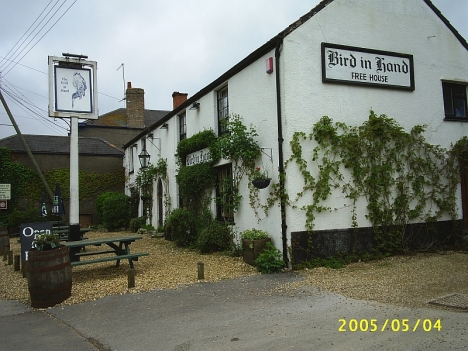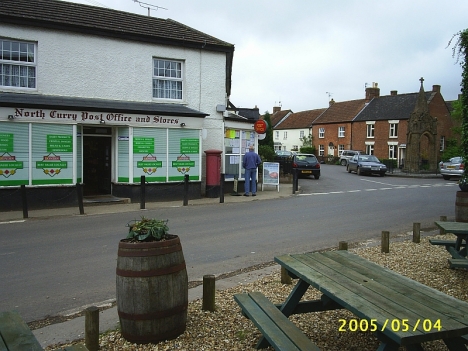Continued from Hayes family in Somerset.
We had breakfast at 7:30, and left Pickford House at Beckington just after 8:00. We had had a very pleasant stay there for two nights.
We drove through Midsomer Norton, because there was a TV detective series called Midsomer Murders. Midsomer Norton looked a rather unprepossessing place, and it turned out that the detective series was filmed in Oxfordshire anyway. We drove down the Cheddar Gorge this time, and went to the post office in Axbridge, where we bought post cards, pens and stationery. We drove up the High Street and round the village. There was a field full of Somerset sheep, which seemed fatter than the Merinos at home, and at the other side of the field there appeared to be two llamas lying down, but they were so far away we could not see them very well.
We called at Wookey Hole, but did not go in to the caves. We drove through Glastonbury, and saw the Tor, which was not nearly as numinous and mysterious as it has been touted to be. We had read in many places that it was supposed to be spooky, and one of the “thin places” of the earth, but it looked quite ordinaryas we drove past. Nearby we passed a sign to Burrowbridge Mump, and we wondered what a “mump” could be — something like a tumulus or tump, perhaps? We saw a roundish hill off to the left, and assumed that that was it. Then we drove along a narrow road across the Somerset flats, lined with basket willows, and turned off to the left, and after about a mile climbed up to North Curry, where my great great great grandfather Simon Hayes was born about 1785.
The sky was overcast and there was a chilly wind blowing. From the hill there was a view a long way over the Somerset Levels. We went to the church, and when we got out of the car we heard the sound of the wind blowing in the trees and the raucous cries of strange birds. That was numinous and mysterious, far more so than Glastonbury, and had a rather menacing atmosphere.
The harsh cries of crows, and some that sounded like owls made it feel somehow unearthly. It was what H.P. Lovecraft might describe as eldritch. The church with its octagonal tower was grey and crumbling and covered with lichen, and looked like an abandoned building from Elidor, something from another time and place. If you are talking about thin places, this was the thinnest place I had ever been in.
Inside the church was also rather impressive, in a somewhat different way, and it seemed to be a lively and active parish. There was an ikon of St Peter & St Paul, and we lit candles in front of it. We had lunch in the Bird in Hand pub, ham eggs and chips, which was expensive, but much better than English food as I remembered it from 40 years ago. In Bath we had gone to a Chinese restaurant, because of my memories of the banality of English cuisine. This was a surprise, and as we continued on our travels we discovered the cooking much better than it had been in the 1960s; perhaps it was the influence of all the cooking shows on TV that seemed to have proliferated in recent years.
The inhabited parts of the village were not nearly as spooky as the bits around the church. Though my ancestor Simon Hayes claimed to have been born here, there was no record of his baptism in the church records, and he appears to have dropped into the world out of nowhere. Perhaps he was a refugee from Elidor.
We left North Curry by a different road, and filled up with petrol before joining the M5 motorway, which took us to the vicinity of Exeter in Devon. We turned off to Dunchideock and Doddiscombesleigh and
the sun came out again as we drove down narrow country lanes with high banks and hedges, so one could see very little other than the narrow sunken lanes ahead.

Devonshire lanes near Dunchideock, with high banks and hedges, and no view of the countryside. 4 May 2005.
We saw nothing more of Dunchideock than a sign on a hedge, and Doddiscombesleigh seemed to be little more than the pub and the church. The pub was the Nobody, and I remembered someone on the British Genealogy newsgroup saying one could get a good meal there, but we’d just had a very adequate meal
at North Curry, and so were not hungry enough. We went on to Ashton in the Teign Valley, where the Stooke family had lived.
My great grandfather William Allen Hayes had married Mary Barber Stooke in Bristol, and then run the Red Lion Hotel in Axbridge. The Stooke family goes back to the 16th century in the Teign valley. Ashton church seemed much deader than the one in North Curry, and was locked.
There was only one monument to the Stookes that we could find in the churchyard, that of Edmund Stooke of Rydon (1788-1860). He was the uncle of my great great grandfather Thomas Stooke, who was born in Chudleigh in 1815.
We then went to Trusham, where Stookes had also lived, and the church was a bit better maintained, and there were monuments to the Stooke family inside the church. We spoke to a woman there who was looking after the church.

Trusham parish church. There are several monuments to members of the Stooke family inside the church. 4 May 2005
Trusham village seemed to be a bit bigger than Ashton, and had more inhabitants.
We went on to Chudleigh, where Thomas Stooke had been born, and parked outside the library, where some kids were skateboarding in the street. I tried to listen for their accents to hear what local
accents sounded like, but everywhere we have been we heard Estuary accents.
We then drove through Bovey Tracey, where a Stooke had been minister in the Commonwealth period, and on to Moretonhampstead, where I had nearly had a job as a kitchen boy in a hotel in 1966, and then across Dartmoor to Tavistock, via Two Bridges. Dartmoor looked a lot like the South African highveld.
We drove up to the A30, and crossed Bodmin Moor and turned off to Blisland just past Jamaica Inn, and stayed at Trewint Farm near the hamlet of Waterloo, run by Mike and Carol. After dumping our cases we drove in to Bodmin, and had supper at the Weavers bar in the middle of town. They had Cornish steaks on the menu, but no Cornish pasties, so we had ham omelets.
The town seemed noisy, with small motor bikes running around. After supper we drove around looking for places where the Growden family had lived at various times, and found Higher Bore Street, which was one of their homes. We drove back over the moor, though around Blisland most of the roads were narrow sunken country lanes with high banks and hedges like those in Devon, so we could not see much of the countryside.
Continued at Bodmin Moor, Cornwall, on election day.
Filed under: family history, genealogy, Hayes family history, holidays, Somerset families, Stooke family history, travel | Tagged: Cornwall, Devon, Devon families, Hayes, Stooke, Teign Valley, thin places, UK trip 2005 |























[…] UK Trip 4 May 2005: Somerset, Devon, Cornwall […]
[…] UK Trip 4 May 2005: Somerset, Devon, Cornwall […]